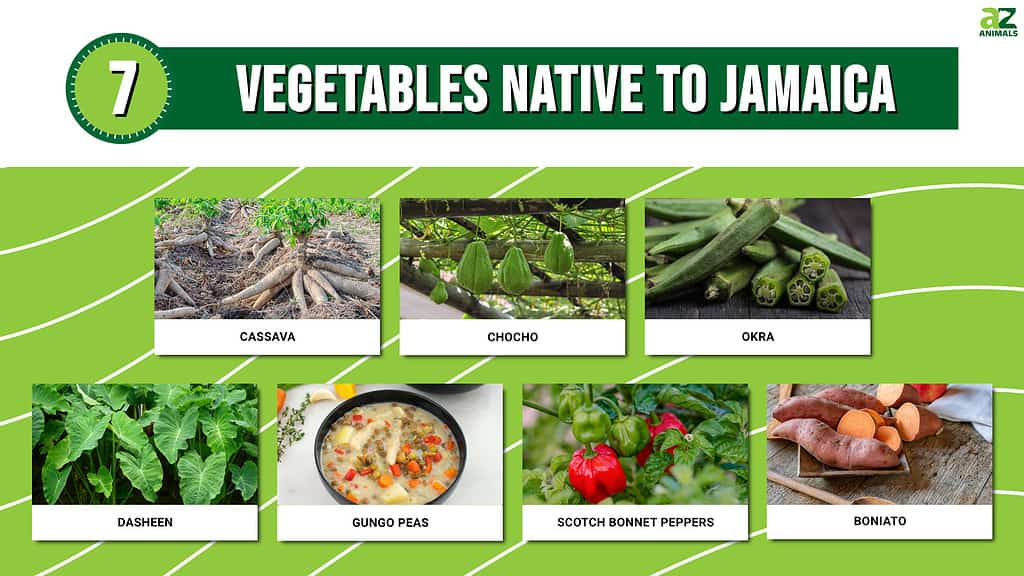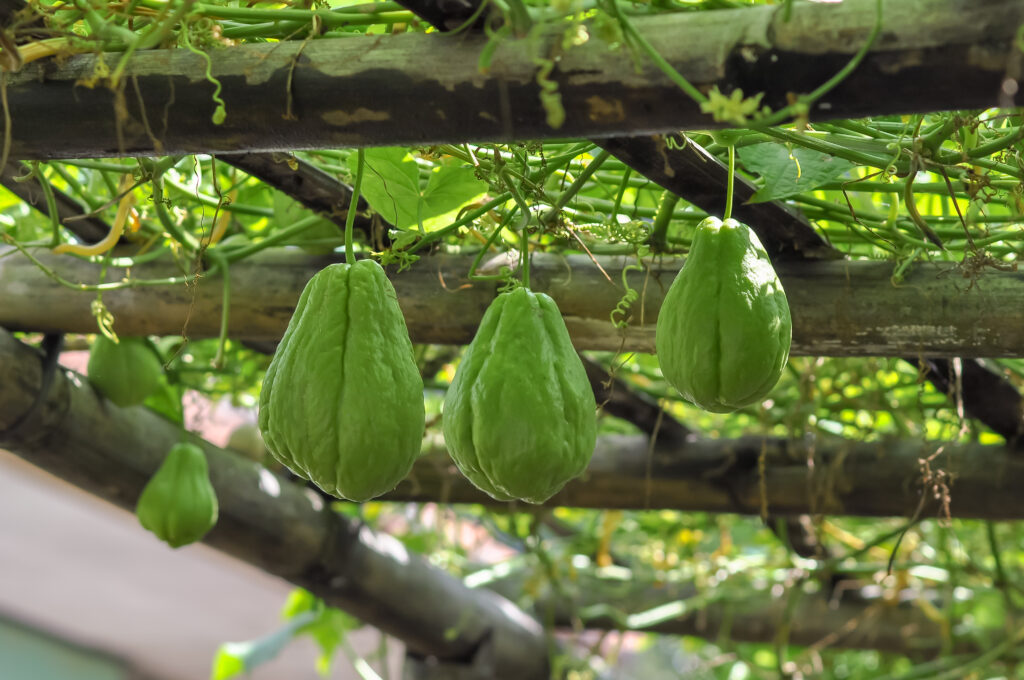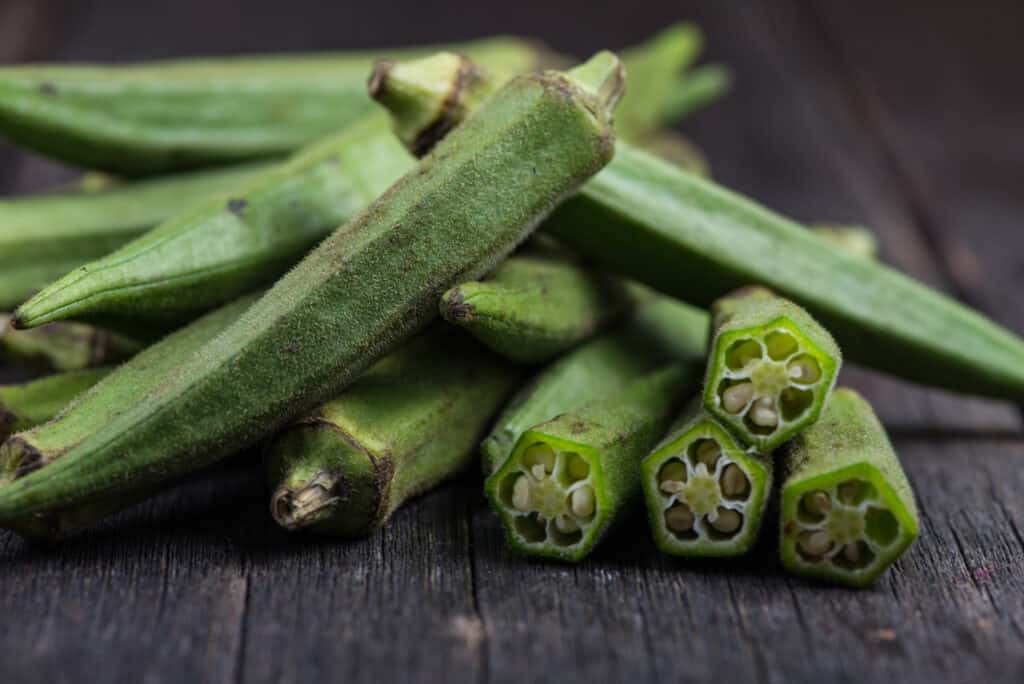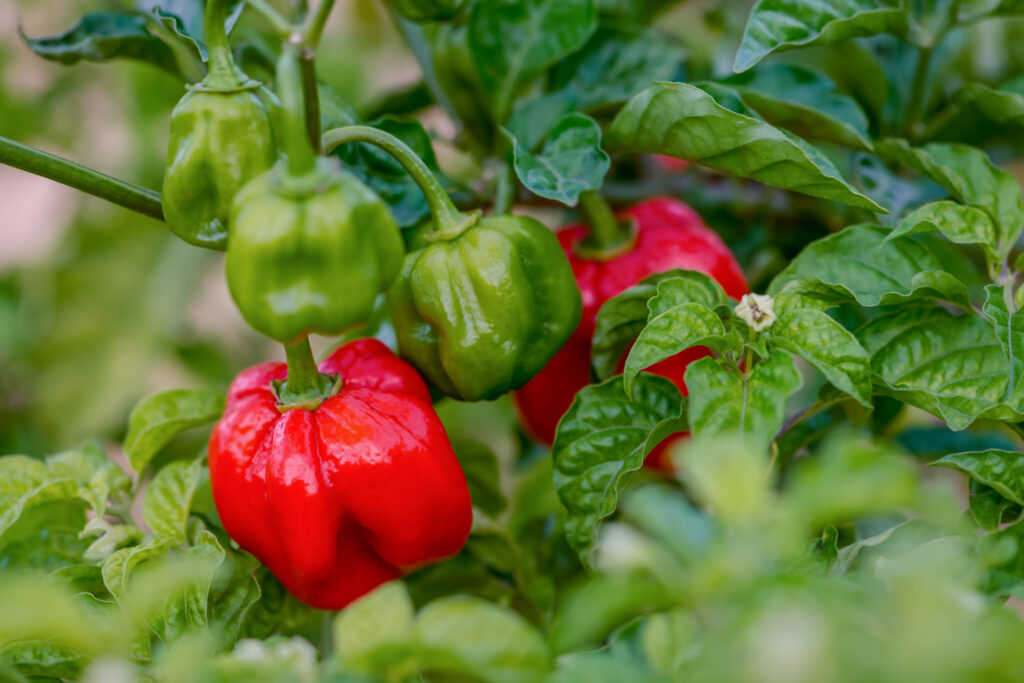With a diverse climate and plentiful rainfall, Jamaica is home to many native vegetables. Many popular Jamaican dishes like jerk chicken and sweet potato pie are made with vegetables indigenous to the country.

Cassava

There are many species of cassava plants, but they are all divided into two categories — bitter and sweet.
©iStock.com/tinglee1631
Perhaps the most widely recognized vegetable native to Jamaica is cassava. Rich in history and vitamin C, this tuber-like plant has been one of the country’s staple crops for thousands of years. There are many species of cassava plants, but they are all divided into two categories — bitter and sweet. Both types of cassava contain hydrocyanic acid, an anti-nutritional compound that contributes to the release of cyanide. Therefore, cassava must be heated and properly processed to remove the cyanide and make it safe for consumption.
Bitter cassava is classified by having a larger amount of hydrocyanic acid. It is most commonly used in a traditional dish known as bammy. Bammy was the main type of bread of the indigenous Jamaican people until wheat bread was imported and became popular.
Sweet cassava is usually prepared by boiling until soft and serving as a vegetable. It is similar in looks and taste to a boiled potato.
Vegetables Native to Jamaica: Chocho (Chayote)

Chayote and pumpkins, cucumbers, and zucchini belong to the gourd family.
©Sukarman/Shutterstock.com
Chayote, colloquially known as chocho, christophene, susu, and a few other names, is classified as a fruit but is used most commonly as a vegetable. It is a type of squash that belongs to the gourd family, along with pumpkins, cucumbers, and zucchini.
Similarly to cassava, chocho has a high amount of vitamin C per serving, meeting 26% of your recommended daily intake. Chocho also has a high amount of antioxidants, which can help reduce inflammation and stress in the body.
Chocho can be consumed raw in salads and smoothies, cooked into soups and stews, or eaten by itself. In any form, it makes for a delicious and nutritious addition to the kitchen.
Okra

Okra was brought to Jamaica hundreds of years ago through the trans-Atlantic slave trade.
©marcin jucha/Shutterstock.com
While not indigenous to the region, okra was brought to Jamaica hundreds of years ago through the trans-Atlantic slave trade. It has since become a staple food in Jamaica, used in soups, stews, and salads. It is low in calories but high in many nutrients and fiber.
When it comes to okra, preparing it as a dessert probably isn’t the first thing that comes to mind. However, Jamaican men believe okra is an aphrodisiac and prepare it in a sweet, blended beverage with oats, nutmeg, and sweetener.
Dasheen

Dasheen is a root vegetable, and similarly to cassava, it must be cooked before eating.
©komkrit Preechachanwate/Shutterstock.com
Also known as taro, Dasheen is one of Jamaica’s many exported foods. It was first grown in Jamaica in the 16th century and brought to the country through the trans-Atlantic slave trade. Dasheen is a root vegetable, and similarly to cassava, it must be cooked before eating. It is a starchy vegetable and compares to a potato in taste.
Dasheen is often referred to as coco, though coco is actually a relative of dasheen. It grows as the root of the elephant ears plant, whose leaves are also used in many dishes. The leaves are similar to spinach, called callaloo, and are eaten with other vegetables after being chopped and lightly steamed.
Vegetables Native to Jamaica: Gungo Peas

Gungo or pigeon peas are used in many Jamaican dishes, including peas, rice, and pea soup.
©Candice Bell/Shutterstock.com
While known by most of the world as pigeon peas, in Jamaica, this legume is colloquially referred to as gungo peas. They are used in many dishes, including peas, rice, and pea soup.
A part of traditional Sunday and Christmas dishes for many Jamaicans, gungo rice and peas are usually served as a side. The peas are boiled in coconut milk and spices and mixed with rice to prepare them. However, unlike a few other vegetables on this list, gungo peas can also be safely consumed raw. They are high in protein, iron, and many other nutrients and low in fat.
Scotch Bonnet Peppers

Scotch Bonnet peppers have a citrusy and tropical flavor.
©Altin Osmanaj/Shutterstock.com
The Scotch Bonnet pepper has a heat range of 150,000 to 325,000 Scoville Heat Units. That’s hotter than jalapeno and cayenne peppers! If you’re brave enough to try a taste, you’ll find that Scotch Bonnet peppers have a citrusy and tropical flavor. Many Jamaican recipes include this pepper, so if you enjoy Caribbean food, you’ve probably tasted a Scotch Bonnet before.
While the origin of Scotch Bonnet peppers isn’t quite clear, they are certainly a big part of Jamaican culture. Used in dishes like jerk chicken and many hot sauces, Scotch Bonnets are excellent for their flavor and heat. As a major agricultural export of Jamaica, they are clearly a popular choice for chefs and food lovers worldwide.
Boniato

This starchy tuber is similar in looks and tastes to a sweet potato and is often called a sweet potato in Jamaica.
©Angelika Heine/Shutterstock.com
With a deep history in the Caribbean, it’s not entirely clear when or how boniato began growing in Jamaica. This starchy tuber is similar in looks and tastes to a sweet potato and is often called a sweet potato in Jamaica. Used in both sweet and savory dishes, boniatos boast a nutty flavor that is unique and tasty.
Boniatos are high in vitamin C and low in fat, making them a very healthy vegetable choice. They’re commonly used in recipes like sweet potato pie and pudding, savory dishes like stews, or as a side pairing to saltfish and peas. One thing is for sure, no matter how boniatos are used in a dish, they add a flavor unlike any other.
Summary of 7 Vegetables Native to Jamaica
| Number | Native Vegetable |
|---|---|
| 1 | Cassava |
| 2 | Chocho (Chayote) |
| 3 | Okra |
| 4 | Dasheen |
| 5 | Gungo Peas |
| 6 | Scotch Bonnett Peppers |
| 7 | Boniato |
The photo featured at the top of this post is © Candice Bell/Shutterstock.com
FAQs (Frequently Asked Questions)
Are cassava and yucca the same plant?
While cassava is also known as yuca, don’t let the similar spelling fool you — yucca is a different plant. Yucca is commonly grown as an ornamental plant, while yuca is used for its edible tubers.
Are dasheen and callaloo part of the same plant?
Yes, dasheen is a tuber-like vegetable that grows at the bottom of the elephant ear plant, and callaloo is the name of a dish made from the plant’s leaves.
Are Scotch Bonnet peppers hotter than Red Savinas?
While Scotch Bonnets are hotter than jalapeño and Serrano peppers according to the Scoville Heat Unit scale, Red Savinas measure on average 200,000 SHU hotter than Scotch Bonnets.
Thank you for reading! Have some feedback for us? Contact the AZ Animals editorial team.






